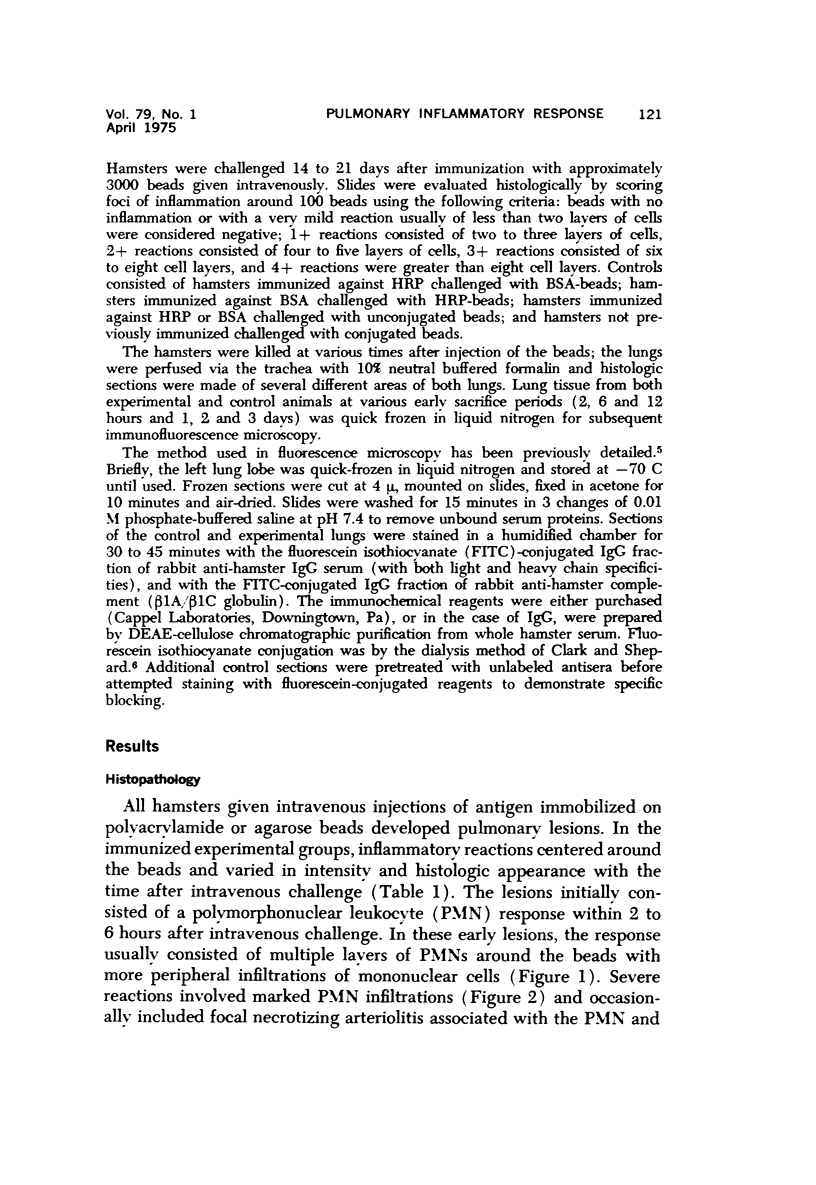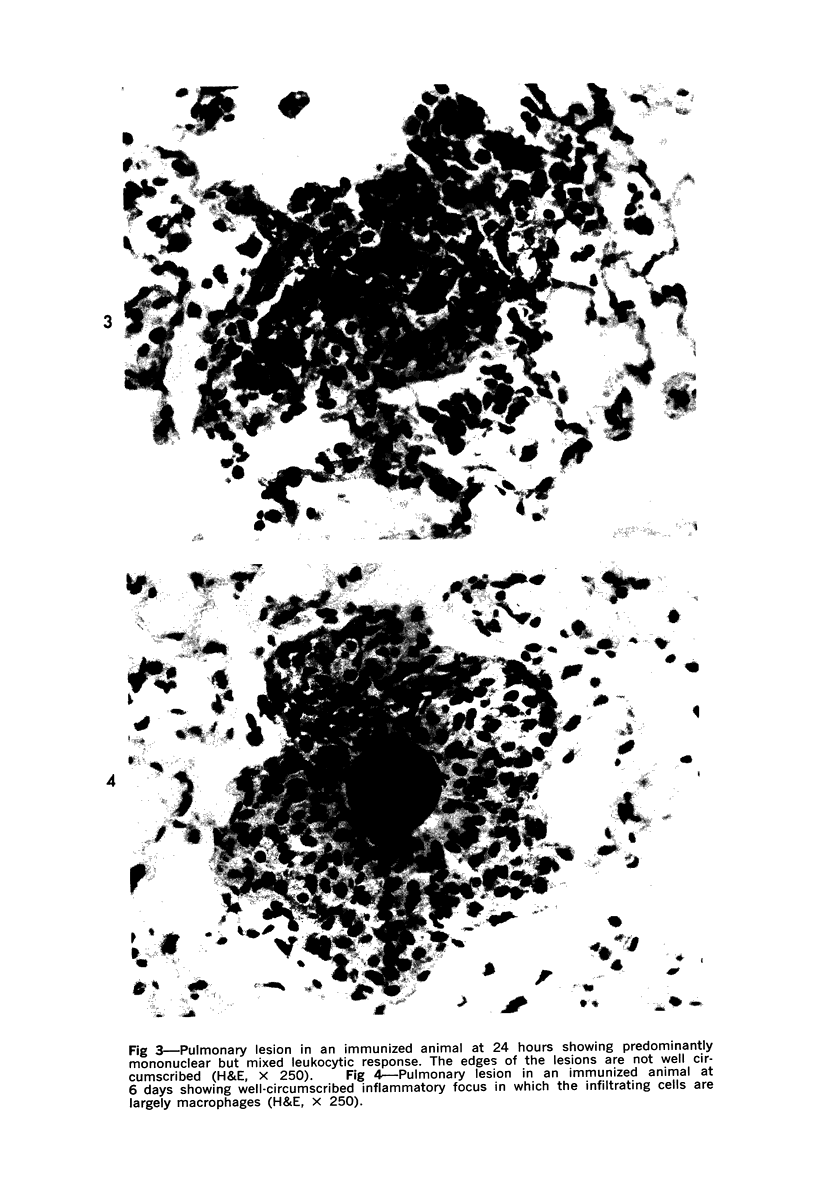Abstract
Horseradish peroxidase (HRP) or bovine serum albumin (BSA) were covalently linked to polyacrylamide or agarose beads and were injected into control Syrian hamsters and hamsters previously immunized with either HRP or BSA. Animals sensitized to soluble antigen and subsequently challenged intravenously with the same antigen immobilized on beads developed an acute focal inflammatory response within 2 to 6 hours after injection. The acute response involved local deposition of IgG and complement (beta1A/beta1C globulin), polymorphonuclear leukocyte exudation, and variable amounts of hemorrhage. A focal vasculitis was occasionally present. Within 72 hours the reaction had become largely mononuclear or granulomatous in nature, and giant cell formation was seen within 4 days after immobilized antigen injection. Severe reactions developed only upon recognition of specific antigenic determinants; thus hamsters immunized against soluble HRP developed characteristic lesions only upon intravenous challenge with HRP-coated beads but not with beads coated with unrelated antigen (BSA). The beads elicited only a mild foreign body reaction in the control hamsters at 5 to 7 days after injection which was temporally and histopathologically distinct from the lesions in immunized hamsters. Thus, the state of existing immunity can influence the character and severity of the local pulmonary inflammatory response.
Full text
PDF











Images in this article
Selected References
These references are in PubMed. This may not be the complete list of references from this article.
- Bloom B. R., Jimenez L. Migration inhibitory factor and the cellular basis of delayed-type hypersensitivity reactions. Am J Pathol. 1970 Sep;60(3):453–468. [PMC free article] [PubMed] [Google Scholar]
- Bosman C., Feldman J. D. Composition, morphology, and source of cells in delayed skin reactions. Am J Pathol. 1970 Feb;58(2):201–218. [PMC free article] [PubMed] [Google Scholar]
- CLARK H. F., SHEPARD C. C. A DIALYSIS TECHNIQUE FOR PREPARING FLUORESCENT ANTIBODY. Virology. 1963 Aug;20:642–644. doi: 10.1016/0042-6822(63)90292-7. [DOI] [PubMed] [Google Scholar]
- Cochrane C. G. Immunologic tissue injury mediated by neutrophilic leukocytes. Adv Immunol. 1968;9:97–162. doi: 10.1016/s0065-2776(08)60442-3. [DOI] [PubMed] [Google Scholar]
- Dvorak H. F., Mihm M. C., Jr, Dvorak A. M., Johnson R. A., Manseau E. J., Morgan E., Colvin R. B. Morphology of delayed type hypersensitivity reactions in man. I. Quantitative description of the inflammatory response. Lab Invest. 1974 Aug;31(2):111–130. [PubMed] [Google Scholar]
- Galindo B. Antigen-mediated fusion of specifically sensitized rabbit alveolar macrophages. Infect Immun. 1972 Apr;5(4):583–594. doi: 10.1128/iai.5.4.583-594.1972. [DOI] [PMC free article] [PubMed] [Google Scholar]
- Henson P. M. Pathologic mechanisms in neutrophil-mediated injury. Am J Pathol. 1972 Sep;68(3):593–612. [PMC free article] [PubMed] [Google Scholar]
- Inman J. K., Dintzis H. M. The derivatization of cross-linked polyacrylamide beads. Controlled introduction of functional groups for the preparation of special-purpose, biochemical adsorbents. Biochemistry. 1969 Oct;8(10):4074–4082. doi: 10.1021/bi00838a026. [DOI] [PubMed] [Google Scholar]
- Kasdon E. J., Schlossman S. F. An experimental model of pulmonary arterial granulomatous inflammation. Am J Pathol. 1973 Jun;71(3):365–372. [PMC free article] [PubMed] [Google Scholar]
- Mariano M., Spector W. G. The formation and properties of macrophage polykaryons (inflammatory giant cells). J Pathol. 1974 May;113(1):1–19. doi: 10.1002/path.1711130102. [DOI] [PubMed] [Google Scholar]
- North R. J., Mackaness G. B. Immunological control of macrophage proliferation in vivo. Infect Immun. 1973 Jul;8(1):68–73. doi: 10.1128/iai.8.1.68-73.1973. [DOI] [PMC free article] [PubMed] [Google Scholar]
- Slauson D. O., Russell S. W., Schechter R. D. Naturally occurring immune-complex glomerulonephritis in the cat. J Pathol. 1971 Feb;103(2):131–133. doi: 10.1002/path.1711030208. [DOI] [PubMed] [Google Scholar]
- Spector W. G. The granulomatous inflammatory exudate. Int Rev Exp Pathol. 1969;8:1–55. [PubMed] [Google Scholar]
- Unanue E. R., Benacerraf B. Immunologic events in experimental hypersensitivity granulomas. Am J Pathol. 1973 Jun;71(3):349–364. [PMC free article] [PubMed] [Google Scholar]
- WARD P. A., COCHRANE C. G., MUELLER-EBERHARD H. J. THE ROLE OF SERUM COMPLEMENT IN CHEMOTAXIS OF LEUKOCYTES IN VITRO. J Exp Med. 1965 Aug 1;122:327–346. doi: 10.1084/jem.122.2.327. [DOI] [PMC free article] [PubMed] [Google Scholar]
- Ward P. A., Offen C. D., Montgomery J. R. Chemoattractants of leukocytes, with special reference to lymphocytes. Fed Proc. 1971 Nov-Dec;30(6):1721–1724. [PubMed] [Google Scholar]










